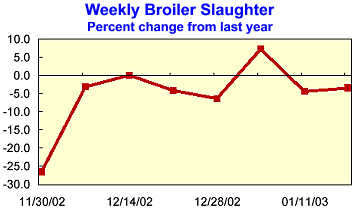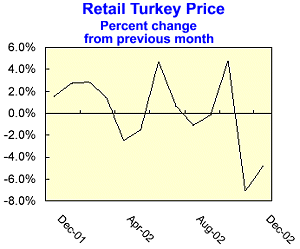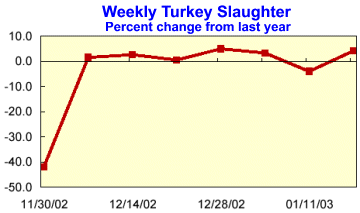



Poultry Outlook Report - January 2003
By U.S.D.A., Economic Research Service - This article is an extract from the January 2003: Livestock, Dairy and Poultry Outlook Report, highlighting Global Poultry Industry data. The outlook for poultry meat trade remains clouded due to proposed measures by Russia and Mexico to limit imports.| Overview |

The outlook for poultry meat trade remains clouded due to proposed measures by Russia and
Mexico to limit imports. Russia has introduced legislation that will place a quota on imports of poultry products by April 1. There are a number of unanswered questions concerning the
implementation of the quota. Although there are indications that the quota will be based on a
quarterly distribution, the method and size of the allocations have not been specified.
In Mexico, tariff rate quotas (TRQs) for poultry products were reduced to zero at the beginning of 2003, as provided for by the North American Free Trade Agreement (NAFTA). However, in response to fears of a large increase in the amount of broiler shipments to Mexico, the Mexican and U.S. Governments are discussing possibly placing TRQs on specific broiler products.
Russia and Mexico were the first and third largest export markets for U.S. broiler products in 2002, and Mexico is the largest market for U.S. turkey products.
| Newcastle Disease Found in California |
The Newcastle disease outbreak in California has now spread to commercial egg-laying flocks after having initially been confined to small non-commercial flocks. Over a million birds have been destroyed. Most of southern California’s counties are under quarantine. The disease outbreak also has impacted poultry trade, with many countries putting restrictions on imports of poultry or poultry products from the United States.
Most of the restrictions are limited to poultry or poultry products produced in California. But, poultry products produced in other areas and shipped out of California ports must be kept in sealed containers. Some countries have gone further: the EU, for example, have banned all imports of poultry meat, hatching eggs, and live birds from the United States. The number of laying hens destroyed so far in California represents less than 1 percent of the national egg laying flock.
| Poultry Trade Outlook Cloudy |
The outlook for poultry meat trade in 2003 remains clouded at the present time due to proposals by Russia and Mexico to limit imports. Russia has introduced legislation that could place a quota on imports of poultry products by April 1.
There are a number of unanswered questions concerning the implementation of the quota. Although there are indications that the quota will be based on a quarterly distribution, the method and size of the allocations have not been specified. If Russian importers feel the quota is below domestic demand, they may import heavily before the quota goes into effect, anticipating higher prices. This could generate wide swings in broiler shipments to Russia depending on price forecasts for the Russian and world markets.
In Mexico, according to the NAFTA, the TRQs for poultry products were reduced to zero at the beginning of 2003. However, in response to fears of a large increase in broiler shipments to Mexico, the Mexican and U.S. Governments are discussing the possibility of placing TRQs on specific broiler products. Russia and Mexico were the first and third largest export markets for U.S. broiler products in 2002, and Mexico is the largest market for U.S. turkey products.
U.S. broiler exports in October 2002 were 468 million pounds, about even with the previous year. Exports over the first 10 months of 2002 were 4.048 billion pounds, down 12 percent from a year ago. As usual, leg quarter exports to Russia made up the bulk of the shipments. In October, shipments of leg quarters to Russia totaled 177 million pounds, 57 percent of all leg quarter exports and 38 percent of all broiler exports.
| Indicators Suggest Lower Broiler Production |
 Weekly broiler hatchery reports continue to show declines in both the numbers of eggs being placed in hatcheries and the number of broiler chicks being placed for growout. During the fourth quarter of 2002, the number of eggs being placed per week in hatcheries averaged 196 million, down 3.1 percent from the same period in 2001.
Weekly broiler hatchery reports continue to show declines in both the numbers of eggs being placed in hatcheries and the number of broiler chicks being placed for growout. During the fourth quarter of 2002, the number of eggs being placed per week in hatcheries averaged 196 million, down 3.1 percent from the same period in 2001.
The number of broiler chicks placed for growout per week averaged 157 million, down 2.9 percent from a year earlier. With continued low prices for most broiler products and uncertainty in the export market, this pattern of lower egg and chick placement is expected to continue into the first quarter of 2003. These reductions imply lower U.S. broiler production through the first half of the year. Broiler production during the first 6 months of 2003 is forecast at 16.25 billion pounds, down slightly from the same period in 2002.
Over the first 9 months of 2002, broiler production was 24.4 billion pounds, 4.1 percent above the previous year, the result of a greater number of birds slaughtered and higher average weights. However, fourth quarter production is forecast about the same as the previous year, a distinct change from the initial outlook.
 Broiler production in November was 2.436 billion pounds, a decrease of 2.6 percent from a year earlier, and slaughter in December is expected to be near the previous year’s level.
Broiler stocks declined in November, with stocks at the end of the month totaling 790 million pounds. This is 65 million pounds lower than the previous month, but still 16 percent higher than at the same time in 2001. Even with a decline in stocks and slightly smaller production in November, most broiler prices have continued to be below the previous year.
Broiler production in November was 2.436 billion pounds, a decrease of 2.6 percent from a year earlier, and slaughter in December is expected to be near the previous year’s level.
Broiler stocks declined in November, with stocks at the end of the month totaling 790 million pounds. This is 65 million pounds lower than the previous month, but still 16 percent higher than at the same time in 2001. Even with a decline in stocks and slightly smaller production in November, most broiler prices have continued to be below the previous year.
The December 12-city average for whole broilers was 54.7 cents per pound, down 2 percent from the previous year. The wholesale composite price for whole broilers and broiler parts was 50.7 cents a pound in December, 11 percent lower than in December 2001. Broiler prices during the first quarter of 2003 will depend to a large part on what impacts the Russian quota and the Mexican trade discussions have on overall broiler shipments.
| Turkey Production Down in November |
 In December, the three-region price for whole turkeys (hens and toms) averaged 63.4 cents per
pound, down less than 1 percent from the previous year. Wholesale prices for whole birds and parts are expected to remain depressed through the next several months, as turkey stocks (whole birds and parts) are still much higher (up 27 percent) than the previous year.
In December, the three-region price for whole turkeys (hens and toms) averaged 63.4 cents per
pound, down less than 1 percent from the previous year. Wholesale prices for whole birds and parts are expected to remain depressed through the next several months, as turkey stocks (whole birds and parts) are still much higher (up 27 percent) than the previous year.
In November, turkey production fell by 2.5 percent as a smaller number of birds slaughtered (down 6.1 percent) more than offset an increase (up 4.1 percent) in the average weight of a bird at slaughter. This is a continuation of the pattern seen in October, with the number of birds down 7 percent from the previous year, but with that decline partially offset by a 5-percent increase in the average weight.
 Over the last 3 months (September through November), the number of poults being placed for growout was down marginally from the same period in 2001. In October, U.S. turkey exports totaled 36.3 million pounds, down slightly from the previous year. However, over the first 10 months of 2002, turkey exports have only been 372 million pounds, a decrease of 7.3 percent from the previous year.
Over the last 3 months (September through November), the number of poults being placed for growout was down marginally from the same period in 2001. In October, U.S. turkey exports totaled 36.3 million pounds, down slightly from the previous year. However, over the first 10 months of 2002, turkey exports have only been 372 million pounds, a decrease of 7.3 percent from the previous year.
Most of the decline has come from smaller shipments to Mexico, which were down 9 percent from the same period in 2001. While exports to Mexico and a number of other markets have been down, they have been partially offset by large increases in shipments to Hong Kong (111 percent) and Canada (22 percent).
| Further information |
Links
For more information view the full Livestock, Dairy and Poultry Outlook - January 2003 (pdf)Source: Livestock, Dairy and Poultry Outlook - U.S. Department of Agriculture, Economic Research Service - January, 2003








